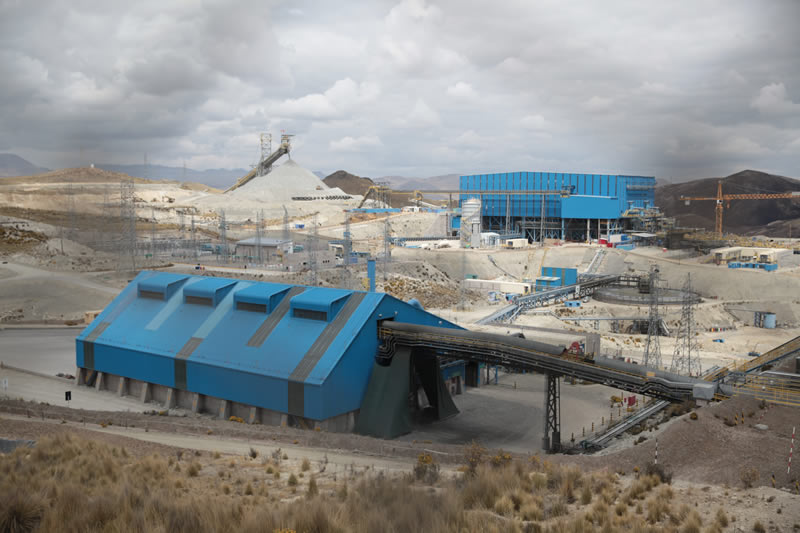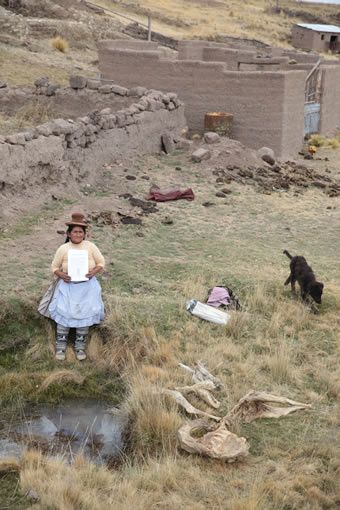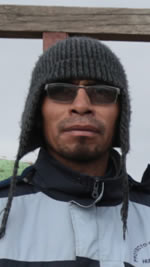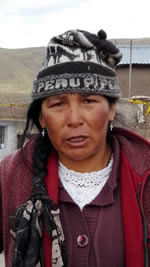ESPINAR
The Toxic Metal Concentration
Camp
In Espinar, Cusco, inhabitants of rural communities are living with excessive minerals in their bodies due to mine waste deposits from the old Xstrata Tintaya mine. Now operated by Glencore, this Swiss giant controls 50% of the world’s copper market.
Map of affected inhabitants
Children, adults and the elderly with 17 minerals in their bodies
Published: 25/11/2015
Updated: 15/02/2018
The Medical Tests Covered Up By The Government
“Grandma, I’ve got heavy metals. How much will I sell them for?” (...) “The boy has no idea that this is an illness that will last forever and ever. Not only for him, for his children too,” says Melchora Surco Rimachi while she squints, her eyes full of tears and rage.
Melchora complains, she gets angry, she’s broken. Yet she still holds her head up high. She is grandmother to Yedamel López Champi, a child born in Espinar, Cusco. When he was just seven years old health workers found heavy metals like lead, arsenic, cadmium and mercury in his urine. These are the four metals classed as highly carcinogenic to humans by the World Health Organization (WHO). In this lab test traces of rare metals such as molybdenum, cobalt, strontium, caesium and tungsten were also found.
In October 2010, the Centro Nacional de Salud Ocupacional y Protección del Ambiente para la Salud (Censopas) [National Centre of Occupational Health and Environment Protection for Health], a branch of the Health Ministry, took urine samples from hundreds of inhabitants of Huisa and Alto Huancané. These communities are located between the Salado and Cañipía rivers, not far from the operations run by the mining firm Xstrata Tinaya. In May 2013, the firm merged with Glencore, the Swiss giant that controls 50% of the global copper market. In 2013, Censopas took new samples for another report. Among these was Yedamel’s. Today he is 10 years old and no longer lives in Alto Huancané, where he grew up.
“The boy thinks ‘I’m rich!I’ve got heavy metals in my body’, little does he know....” Melchora Surco, president of the Alto Huancané community.
Melchora Surco,president of the Alto Huancané community.
His family took him to the city of Espinar to avoid exposing him to the contamination. Many others have done the same. Turned into environmental refugees, they share the same uncertainty as women, men, children and elderly who haven’t been able to flee.
“Wherever we go, we already have metals in our bodies. It’s too late. “Where can I escape to?” Asks 60-year-old Melchora during our visit to Espinar. Convoca arrived here with La República, a Lima based newspaper, to investigate the impact mining has had on the health of these rural communities in the Cusco highlands, five hours away by van from this region´s capital.
Our team accessed new documents and lab results from more than 100 inhabitants who authorised their distribution. They form part of the latest study carried out by Censopas in 2013. The figures were put into an Excel spreadsheet in order to establish new findings that would then be reviewed by doctors, toxicologists and related workers. This is the first part of an investigation that reveals that five years have passed, during which time negligence and half-truths have made it difficult for people in Espinar even to find a medical solution by their own.
A Body of Minerals
Excess contaminating metals in the bodies of hundreds of inhabitants of Alto Huancané and Huisa have largely been proven in the two Censopas reports. The first of them was carried out in 2010, and the publication of its findings triggered a social conflict that ended up with people deceased and injured.
No solution has been found up to this date. A 100% of the people who underwent the test had been exposed to arsenic (332 samples), mercury (231), cadmium (254) and lead (492). Moreover, 29 of these samples were above the WHO’s benchmarks for arsenic, 24 for mercury, 11 for cadmium and 9 for lead. However, these inhabitants didn’t know that they were contaminated with heavy metals until May 2013. In fact, they would have never found it out should Quechua (a Pan Pacific subsidiary and copper producer) had not asked Censopas to carry out this study in the mining area of Espinar. This mine´s influential area coincidentally overlaps the one in Tintaya.
- 52 cases
exceed the
WHO’s
thresholds - 32 cases
show an
excess of
arsenic and
lead
- 52 cases exceed the WHO’s thresholds
- 32 cases
show an excess
of arsenic and
lead
In 2013, Censopas carried out its second study on behalf of a committee (called Mesa de Diálogo, in Spanish) lead by the Environmental Ministry and formed by congressmen, local authorities and company representatives to solve the social conflict. This time 180 urine samples were taken. Yedamel’s was among them. In January 2013, Censopas sent the samples to the CDC (Center for Disease Control and Prevention) in the USA. An excess of at least one of the seventeen metals was found in every sample. Convoca carried out its own analysis on these results and found that in at least 52 of these cases there were levels above the WHO’s threshold. The most common minerals were arsenic and lead. Both were registered in 32 cases.

Antapaccay mining project operations, now operated by Glencore. Photo: Miguel Mejía - La República newspaper.
The analysis confirmed what has been known since 2010 in terms of lead, arsenic, mercury and cadmium. In addition, the analysis showed surprising results about Espinar’s exposure to substances such as uranium and molybdenum. The analysis also found eleven other substances for which donors had not even given their consent.
Of the 17 metals, the consensual tests of six substances were handed over to the inhabitants after they became public at the Mesa de Dialogo in August 2013. Meanwhile, the other 11 remained in the hands of Censopas and were not handed over until December 2014.
People who were tested received unsealed proof of the results. Doctor María del Carmen Gastañaga was head of Censopas when the study was carried out in 2010 and has now returned to the position. In a short telephone conversation, she told Convoca that Censopas only served as a middle man between the CDC and the researchers who were in charge, Carlos Sánchez Zavaleta and Fernando Osores. Sánchez claims that this was “completely false.”
“They sent us the results as if it were a joke, unsigned,” says Santusa Noñonca de Kana, who lives 360 metres away from the Camaccmayo tailings dam in Alto Huancané. There are puddles of yellowish water in Santusa’s backyard and in one of the rooms in her house. “I asked Mr Pulgar Vidal (the Environment minister) if we were going to live like that with that stinking water. How far away from the dump will we have to live?” says Santusa angrily as she remembers the minister’s visit to her house.
On May 2012 the minister of environment assured that Censopas’ investigation had not taken place in the area that was affected by, at the time in question, the Xstrata mining company. Today, more than three years later, the Deputy Minister of Environmental Management, Mariano Castro, acknowledged in a response sent by mail last night, that some communities, like Huisa, “are located at the intersection of the area affected” by the Quechua project and that of Tintaya Antapaccay.
Under the Waste Deposits
In the Paccpaco sector of Alto Huancané people live up to just 100 meters from the Camaccmayo tailings deposit held by Xstrata Tintaya, and dozens of local villagers have shown traces of metals in their bodies, according to records collected by Convoca in the area. The same applies to the Huisa community in the Chipta sector, where Ceferino Kana Achiri lives in front of the Huinipampa tailings deposit, with his wife Teresa and their two children.
In fixed penalty notices upheld by the Agency for Assessment and Environmental Control (Organismo de Evaluación y Fiscalización Ambiental - OEFA), between 2010 and 2014, at least three violations related to mismanagement of the mining company’s waste deposits, appear. Among the most frequent offenses detected inside and outside the mine in seven penalty cases, include failure to comply with environmental protection standards, effluent discharges, dumping of tailings and erosion of natural soil.
The Antapaccay mining company replied that "it is not responsible for the contamination of Espinar" and that the presence of "very small amounts of heavy metals" in the waters is due to "geological or natural causes" as stated in a monitoring report on environmental health conducted in 2013 as part of the round-table discussion.
"The people who were examined received the documentation of the test results unsealed".

Santusa Noñonca, resident of Alto Huancané. Photo: Miguel Mejía - La República.
The dozens of Interviewed villagers have complained that the Espinar doctors gave them a clean bill of health despite of the high concentrations of metals in their bodies. They do not believe in these diagnoses, and they worried about the risks. The human body tends to secrete heavy metals that enter the organism, either through sweat, urine, or feces. Metals that are more difficult to filter are "chelated", that is to say that our body captures and removes them from the bloodstream whereupon they accumulate in various keloid tissues or in the bones. This process is largely influenced by the time and intensity of exposure.
If the exposure to heavy metals and other substances has been too long and consistent, and has exceed the threshold of our body’s ability to process them, it is possible – metaphorically speaking - that metals will mutate in our organism into a time bomb, as explained by Dr. Raul Loayza, coordinator at the ecotoxicology laboratory of the University Peruana Cayetano Heredia.
“If the exposure to heavy metals and other substances has been too long and consistent, it is possible (...) that our organism will mutate into a time bomb”.
There is a chance that the bomb can be inactive today, and that these people, continuously exposed to contamination, may accumulate metals in the keloid tissue and bones for years, without experiencing any notable health problems. The biologist Carlos Sanchez Zavaleta exemplifies with the case of a child from La Oroya who had four times more lead in his blood than the quantity that the WHO recommends for a healthy life. With these levels of lead, the child should have cancer or serious neurological problems. However, exceptionally, he showed no symptoms. What is undeniable is that this young boy’s chances of developing cancer are multiplied. If the keloids that isolate these heavy metals in our body, fail, and the metal is activated, it is more than likely that those tissues will develop a cancer.
"What the WHO standards they tell us", said Loayza, "is how much lead (or mercury, arsenic and cadmium) we can tolerate without risking our health". The words of the expert become imperative when bearing in mind that the Ministry of Health, since July 2005, has had a national plan to strengthen the environmental management and reduce the number of deaths caused by heavy metal poisoning. As a part of that plan, guidelines for clinical practices for the management of patients with acute and chronic lead poisoning were approved between 2007 and 2011.
"Yes there are people with values above normal and they need to be evaluated on an ongoing basis".
José Bernable, head of the Regional Health Authorities of Cusco.
The human body does not need lead, arsenic or mercury to function normally. Therefore, according to the plan and the approved guidelines, no matter if the metal levels found were above or below the limits set by the WHO, the State was obliged to take immediate action. Convoca asked Joseph Bernable Villasante from the Cusco Regional Health Authorities about the matter and he responded that the guidelines do not provide detailed information for medical treatment. This is not true; the guidelines even specify the treatment according to the level of mineral exposure.
In an analysis of the health situation of Cusco, ordered by the same Regional Health Authorities that was published in 2013, it appears that the primary cause of mortality in the province Espinar is kidney failure: out of 799 deaths in Espinar in 2011, 97 were caused by this condition. The report states that this tendency, "would show that we are entering a process of epidemiological transition in the province of Espinar" and stresses that it is unusual with such high mortality promoters in the area. It was recommended that an investigation of this cause of deaths be made.
By the deadline for submission of this article, Deputy Minister Castro assured that the dialogue table has other prioritized "the health of the people" and has even developed a health action plan for Espinar. But the people interviewed question the medical care they have received so far. Their statements will appear in the second part of this report.
TESTIMONIALS
Residents of the communities of Huisa and Alto Huancané tell how they are affected by minerals in their bodies. (Click on each photo to see video).
METHODOLOGY
In this research, Convoca had access to roughly a hundred official results from 2013 concerning the communities of Huisa and Alto Huancané’s exposure to 17 heavy metals in the province of Espinar (Cusco) and various documents that made it possible to determine the level of concentration of minerals in the body of these people. In addition, doctors and toxicologists were interviewed in order to establish parameters validated by the scientific community. The inhabitants and the leaders of both communities authorized Convoca to publish the test results from the laboratory.
How the main outcome of the article was obtained?
To assess the level of exposure to these minerals for the 180 tested villagers, Convoca designed a spreadsheet of over three thousand lines in which the results of the villagers were entered for each of the 17 metals, which were sent by the United States Center for Disease Control and Prevention (CDC) to the National Center for Occupational Health and Environmental protection for Health (CENSOPAS). The latter government agency collected the urine samples for screening.
The CDC assigned the results to CENSOPAS with a code for each person tested, that did not identify their names. It did not take the World Health Organization (WHO) parameters into account but favored its own methodology which was based on percentiles of the US population. Given that these parameters do not apply to the Peruvian population, and particularly for people living in Andean areas, Convoca included the parameters set by WHO for arsenic, cadmium, mercury and lead, classified as toxic to human health.
As there are no limits (neither by the WHO nor by Peruvian law) to the other 13 minerals that the CDC evaluated, it was only registered on the list whether there had been exposure to these metals or not. Thus, the following categories in the spreadsheet were considered: code of tested person, mineral type, parameters, percentage exceeded, and if there had been exposure to the metal or not.
How was the data elaborated on the map?
The map shows the distance between the homes of the tested people and the tailings deposits. In addition, it also shows the results of 119 people. At this early stage of research, Convoca had access to the results of 17 heavy metals of 22 community members and 11 metals of 97 residents.
An index card of each of the residents is attached to the map.There are 22 community members that delivered to us their complete results. In these cases, analysis included WHO and CDC parameters, so the reader can compare the outcome to both.
During fieldwork, Convoca mapped the distance between houses and tailings deposits with a GPS, and also validated the house locations with the villagers themselves through Google Maps.
The map will continue to be fed with more information.
CREDITS
Edition: Milagros Salazar. Research: Gabriel Arriarán and Milagros Salazar. Data analysis: Cristian Espinoza and Aramís Castro. Video and audio editing: Stefany Aquise. Photographs: Miguel Mejía (La República) and Milagros Salazar. Home page: Photographs by Miguel Mejía and composition by Convoca. Web development: Interself.pe. Map: Victor Anaya. Translated by: Daniel Griffiths and Majka Bjørnager. Reviewed by: Louella Mahabir and Gabriel Arriarán (Convoca). Coordination: Juan Arellano for Traduciendo América Latina, a project of Global Voices in Spanish.
We thank the physicians, toxicologists and experts who contributed to this research. And especially the residents of Espinar that opened the doors to their homes and told us their stories.























